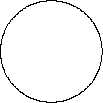NUCLEAR FISSION
DOE-HDBK-1019/1-93
Atomic and Nuclear Physics
Figure 18 Liquid Drop Model of Fission
Critical Energy
The measure of how far the energy level of a nucleus is above its ground state is called the
excitation energy (Eexc). For fission to occur, the excitation energy must be above a particular
value for that nuclide. The critical energy (Ecrit) is the minimum excitation energy required for
fission to occur.
Fissile Material
A fissile material is composed of nuclides for which fission is possible with neutrons of any
energy level. What is especially significant about these nuclides is their ability to be fissioned
with zero kinetic energy neutrons (thermal neutrons). Thermal neutrons have very low kinetic
energy levels (essentially zero) because they are roughly in equilibrium with the thermal motion
of surrounding materials. Therefore, in order to be classified as fissile, a material must be
capable of fissioning after absorbing a thermal neutron. Consequently, they impart essentially
no kinetic energy to the reaction. Fission is possible in these materials with thermal neutrons,
since the change in binding energy supplied by the neutron addition alone is high enough to
exceed the critical energy. Some examples of fissile nuclides are uranium-235, uranium-233, and
plutonium-239.
NP-01
Page 50
Rev. 0







